Regulatory B10 cells differentiate into antibody-secreting cells after transient IL-10 production in vivo
- PMID: 22198952
- PMCID: PMC3262922
- DOI: 10.4049/jimmunol.1102500
Regulatory B10 cells differentiate into antibody-secreting cells after transient IL-10 production in vivo
Abstract
Regulatory B cells that are functionally defined by their capacity to express IL-10 (B10 cells) downregulate inflammation and autoimmunity. In studies using well-defined IL-10 reporter mice, this rare B10 cell subset was also found to maintain a capacity for plasma cell differentiation. During a transient period of il10 transcription, the blimp1 and irf4 transcription factors were induced in B10 cells, whereas pax5 and bcl6 were downregulated as a significant fraction of B10 cells completed the genetic and phenotypic program leading to Ab-secreting cell differentiation in vitro and in vivo. B10 cell-derived IgM reacted with both self- and foreign Ags, whereas B10 cells generated Ag-specific IgG in response to immunizations. Moreover, B10 cells represented a significant source of serum IgM and IgG during adoptive-transfer experiments and produced Ag-specific, polyreactive and autoreactive Ab specificities that were consistent with their expression of a diverse AgR repertoire. Thereby, B10 cells limit inflammation and immune responses by the transient production of IL-10, and may facilitate clearance of their eliciting Ags through an inherent capacity to quickly generate polyreactive and/or Ag-specific Abs during humoral immune responses.
Figures
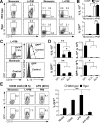
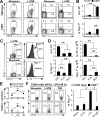
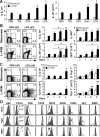
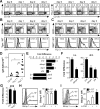
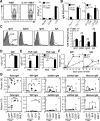
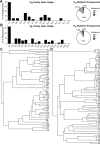

Similar articles
-
Amplified B lymphocyte CD40 signaling drives regulatory B10 cell expansion in mice.PLoS One. 2011;6(7):e22464. doi: 10.1371/journal.pone.0022464. Epub 2011 Jul 25. PLoS One. 2011. PMID: 21799861 Free PMC article.
-
T follicular helper cells mediate expansion of regulatory B cells via IL-21 in Lupus-prone MRL/lpr mice.PLoS One. 2013 Apr 24;8(4):e62855. doi: 10.1371/journal.pone.0062855. Print 2013. PLoS One. 2013. PMID: 23638156 Free PMC article.
-
Blimp-1 Contributes to the Development and Function of Regulatory B Cells.Front Immunol. 2019 Aug 14;10:1909. doi: 10.3389/fimmu.2019.01909. eCollection 2019. Front Immunol. 2019. PMID: 31474988 Free PMC article.
-
B10 cell regulation of health and disease.Immunol Rev. 2014 May;259(1):259-72. doi: 10.1111/imr.12176. Immunol Rev. 2014. PMID: 24712471 Free PMC article. Review.
-
Regulatory B10 cell development and function.Int Immunol. 2015 Oct;27(10):471-7. doi: 10.1093/intimm/dxv046. Epub 2015 Aug 6. Int Immunol. 2015. PMID: 26254185 Free PMC article. Review.
Cited by
-
Frontiers of Autoantibodies in Autoimmune Disorders: Crosstalk Between Tfh/Tfr and Regulatory B Cells.Front Immunol. 2021 Mar 26;12:641013. doi: 10.3389/fimmu.2021.641013. eCollection 2021. Front Immunol. 2021. PMID: 33841422 Free PMC article. Review.
-
Deconvolution of B cell receptor repertoire in multiple sclerosis patients revealed a delay in tBreg maturation.Front Immunol. 2022 Aug 16;13:803229. doi: 10.3389/fimmu.2022.803229. eCollection 2022. Front Immunol. 2022. PMID: 36052064 Free PMC article.
-
Human IL-10-producing B cells have diverse states that are induced from multiple B cell subsets.Cell Rep. 2022 Apr 19;39(3):110728. doi: 10.1016/j.celrep.2022.110728. Cell Rep. 2022. PMID: 35443184 Free PMC article.
-
Guidelines for the use of flow cytometry and cell sorting in immunological studies (third edition).Eur J Immunol. 2021 Dec;51(12):2708-3145. doi: 10.1002/eji.202170126. Epub 2021 Dec 7. Eur J Immunol. 2021. PMID: 34910301 Free PMC article. Review.
-
Chronic Lymphocytic Leukemia B-Cell Normal Cellular Counterpart: Clues From a Functional Perspective.Front Immunol. 2018 Apr 4;9:683. doi: 10.3389/fimmu.2018.00683. eCollection 2018. Front Immunol. 2018. PMID: 29670635 Free PMC article. Review.
References
-
- DiLillo DJ, Matsushita T, Tedder TF. B10 cells and regulatory B cells balance immune responses during inflammation, autoimmunity, and cancer. Ann. N. Y. Acad. Sci. 2010;1183:38–57. - PubMed
-
- Mizoguchi A, Bhan AK. A case for regulatory B cells. J. Immunol. 2006;176:705–710. - PubMed
-
- Fillatreau S, Sweenie CH, McGeachy MJ, Gray D, Anderton SM. B cells regulate autoimmunity by provision of IL-10. Nat. Immunol. 2002;3:944–950. - PubMed
Publication types
MeSH terms
Substances
Grants and funding
LinkOut - more resources
Full Text Sources
Other Literature Sources
Molecular Biology Databases

